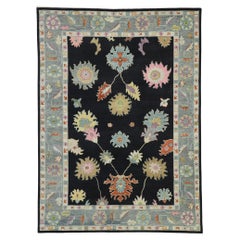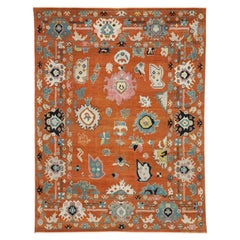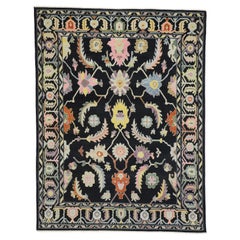Takashi Murakami Rug
21st Century and Contemporary Indian Oushak Turkish Rugs
Wool
Recent Sales
21st Century and Contemporary Indian Post-Modern Turkish Rugs
Wool
21st Century and Contemporary Indian Oushak Turkish Rugs
Wool
21st Century and Contemporary Turkish Post-Modern Turkish Rugs
Wool
People Also Browsed
2010s Indian Modern Persian Rugs
Wool
2010s Indian Mid-Century Modern Indian Rugs
Cotton
Early 20th Century Austrian Aubusson Western European Rugs
Wool
A Close Look at Post-modern Furniture
Postmodern design was a short-lived movement that manifested itself chiefly in Italy and the United States in the early 1980s. The characteristics of vintage postmodern furniture and other postmodern objects and decor for the home included loud-patterned, usually plastic surfaces; strange proportions, vibrant colors and weird angles; and a vague-at-best relationship between form and function.
ORIGINS OF POSTMODERN FURNITURE DESIGN
- Emerges during the 1960s; popularity explodes during the ’80s
- A reaction to prevailing conventions of modernism by mainly American architects
- Architect Robert Venturi critiques modern architecture in his Complexity and Contradiction in Architecture (1966)
- Theorist Charles Jencks, who championed architecture filled with allusions and cultural references, writes The Language of Post-Modern Architecture (1977)
- Italian design collective the Memphis Group, also known as Memphis Milano, meets for the first time (1980)
- Memphis collective debuts more than 50 objects and furnishings at Salone del Milano (1981)
- Interest in style declines, minimalism gains steam
CHARACTERISTICS OF POSTMODERN FURNITURE DESIGN
- Dizzying graphic patterns and an emphasis on loud, off-the-wall colors
- Use of plastic and laminates, glass, metal and marble; lacquered and painted wood
- Unconventional proportions and abundant ornamentation
- Playful nods to Art Deco and Pop art
POSTMODERN FURNITURE DESIGNERS TO KNOW
- Ettore Sottsass
- Robert Venturi
- Alessandro Mendini
- Michele de Lucchi
- Michael Graves
- Nathalie du Pasquier
VINTAGE POSTMODERN FURNITURE ON 1STDIBS
Critics derided postmodern design as a grandstanding bid for attention and nothing of consequence. Decades later, the fact that postmodernism still has the power to provoke thoughts, along with other reactions, proves they were not entirely correct.
Postmodern design began as an architectural critique. Starting in the 1960s, a small cadre of mainly American architects began to argue that modernism, once high-minded and even noble in its goals, had become stale, stagnant and blandly corporate. Later, in Milan, a cohort of creators led by Ettore Sottsass and Alessandro Mendini — a onetime mentor to Sottsass and a key figure in the Italian Radical movement — brought the discussion to bear on design.
Sottsass, an industrial designer, philosopher and provocateur, gathered a core group of young designers into a collective in 1980 they called Memphis. Members of the Memphis Group, which would come to include Martine Bedin, Michael Graves, Marco Zanini, Shiro Kuramata, Michele de Lucchi and Matteo Thun, saw design as a means of communication, and they wanted it to shout. That it did: The first Memphis collection appeared in 1981 in Milan and broke all the modernist taboos, embracing irony, kitsch, wild ornamentation and bad taste.
Memphis works remain icons of postmodernism: the Sottsass Casablanca bookcase, with its leopard-print plastic veneer; de Lucchi’s First chair, which has been described as having the look of an electronics component; Martine Bedin’s Super lamp: a pull-toy puppy on a power-cord leash. Even though it preceded the Memphis Group’s formal launch, Sottsass’s iconic Ultrafragola mirror — in its conspicuously curved plastic shell with radical pops of pink neon — proves striking in any space and embodies many of the collective’s postmodern ideals.
After the initial Memphis show caused an uproar, the postmodern movement within furniture and interior design quickly took off in America. (Memphis fell out of fashion when the Reagan era gave way to cool 1990’s minimalism.) The architect Robert Venturi had by then already begun a series of plywood chairs for Knoll Inc., with beefy, exaggerated silhouettes of traditional styles such as Queen Anne and Chippendale. In 1982, the new firm Swid Powell enlisted a group of top American architects, including Frank Gehry, Richard Meier, Stanley Tigerman and Venturi to create postmodern tableware in silver, ceramic and glass.
On 1stDibs, the vintage postmodern furniture collection includes chairs, coffee tables, sofas, decorative objects, table lamps and more.
Finding the Right Rugs And Carpets for You
Good antique rugs and vintage rugs have made their way into homes across the globe, becoming fixtures used for comfort, prayer and self-expression, so choosing the right area rug is officially a universal endeavor.
In modern usage, “carpet” typically denotes a wall-to-wall floor cushioning that is fixed to the floor. Rugs, on the other hand, are designed to cover a specific area and can easily be moved to new locations. However, the terms are interchangeable in many parts of the world, and, in the end, it won’t matter what you decide to call it.
It’s well known that a timeless Persian rug or vintage Turkish rug can warm any interior, but there are lots of other styles of antique rugs to choose from when you're endeavoring to introduce fresh colors and textures to a bedroom or living room.
Moroccan Berber rugs are not all about pattern. In fact, some of the most striking examples are nearly monochrome. But what these rugs lack in complexity, they make up for in brilliant color and subtle variation. Moroccan-style interiors can be mesmerizing — a sitting room of this type might feature a Moroccan rug, carved wooden screens and a tapestry hung behind the sofa.
Handwoven kilim rugs, known for their wealth of rich colors and unique weaving tradition, are pileless: Whereas the Beni Ourain rugs of Morocco can be described as dense with a thick surface or pile, an authentic kilim rug is thin and flat. (The term “kilim” is Turkish in origin, but this type of textile artistry is practiced all across the Balkans, throughout the Arab world and elsewhere.)
When it comes to eye-catching floor coverings, the distinctive “medallion” pattern of Oushak rugs has two types of rounded shapes alternating against a rich red or blue background created with natural dyes, while the elaborate “star” pattern involves large eight-pointed shapes in diagonal rows alternating with diamonds.
If you’re looking for something unexpected, find a runner rug that pops in your hallway or on your stairs. Dig for dazzling geometric patterns in our inventory of mid-century modern rugs and carpets, which includes works designed by the likes of Swedish textile masters Märta Måås-Fjetterström, Marianne Richter and other artisans.
Carpets and rugs have been around for thousands of years. Prehistoric humans turned to animal skin, wool and fur to craft simple fabrics to soften hard terrain. A 2016 study suggests that "cave lions" were hunted for exactly this purpose, and that decorating your cave with their pelts may have conferred strength and prestige. Although many of these early textiles are still in existence, tracing their precise origins is difficult. Carpets quickly became such a valuable trade commodity that the weavings could easily travel far from their places of origin.
The oldest known carpet was found in southern Siberia. (It may have traveled there from Persepolis in Iran.) For the flat-weave floor rugs crafted by Native Americans, cotton was the primary material before sheep’s wool was introduced in the 16th century. In Europe, carpet-making was fundamental to folk art, and Asian carpets imported to European countries were at one time considered a precious luxury and not intended to remain permanently on the floor.
With the variety of area rugs and carpets rolled out for you on 1stDibs — a collection that includes traditional, modern, minimalist rugs and other coverings of all kinds — things will be looking up whenever you’re looking down.
- Who is Takashi Murakami?1 Answer1stDibs ExpertMarch 22, 2022Takashi Murakami is a Japanese contemporary artist. He coined the term "Superflat" to describe his work, which draws inspiration from two-dimensional anime cartoons and manga comics popular in Japan. Murakami was born in Tokyo, Japan, on February 1, 1962. You'll find a collection of Takashi Murakami art on 1stDibs.
- When was Takashi Murakami born?1 Answer1stDibs ExpertMarch 22, 2022Takashi Murakami was born on February 1, 1962, in Tokyo, Japan. He studied at the Tokyo University of the Arts, earning a Ph.D. in art. He currently lives in both Tokyo and New York City. On 1stDibs, find a collection of Takashi Murakami art.
- Where was Takashi Murakami born?1 Answer1stDibs ExpertMarch 22, 2022Takashi Murakami was born in Tokyo, Japan, on February 1, 1962. He received a Ph.D. in art from the Tokyo University of the Arts in 1993. During the 1990s, he shifted from the traditional Japanese painting style of nihonga and began creating bold, colorful works inspired by anime and manga. He calls his style Superflat. On 1stDibs, find a range of Takashi Murakami art.
- 1stDibs ExpertAugust 8, 2024Artwork by Takashi Murakami is so expensive, largely due to a great demand for a limited supply of pieces. Murakami may be famous among collectors for the psychedelic flowers and chaotic cartoons that populate his prints and paintings, but artists likely know him as the theorist behind the contemporary art movement he calls “Superflat." Partially inspired by the Pop art of Andy Warhol, in which celebrity culture and mundane mass-produced items became the focus of bright and colorful works that both celebrated and criticized consumerism, Murakami’s Superflat encompasses painting, sculpture, digital design and more to present a subversive look at consumerism. It is also an effort to blend fine art and lowbrow culture. The Japanese artist has collaborated with brands such as Louis Vuitton, and one of his most famous Superflat works is the teddy bear on the cover of the Graduation album by American rapper Kanye West. These collaborations and connections to pop culture have increased Murakami's fame and contributed to the demand for his work. On 1stDibs, shop a diverse assortment of Takashi Murakami art.
- 1stDibs ExpertMarch 22, 2022Takashi Murakami lives and works in both Tokyo, Japan, and New York, New York. He was born in Tokyo on February 1, 1962, and he graduated from the Tokyo University of the Arts with a Ph.D. in art. On 1stDibs, find a collection of Takashi Murakami art.
- 1stDibs ExpertMarch 22, 2022You can buy Takashi Murakami in a variety of ways. Options include working with a reputable art dealer or buying through an auction house. You can also find his artwork on various online platforms. Shop a variety of Takashi Murakami art on 1stDibs.
- 1stDibs ExpertMarch 22, 2022Over the years, Takashi Murakami has worked with many designers. His collaboration with Louis Vuitton in 2003 opened the doors to collaborations with Kanye West, Billionaire Boys Club, Kaws, Hublo and Pharrell Williams. On 1stDibs, shop a variety of Takashi Murakami art.
- 1stDibs ExpertApril 5, 2022Takashi Murakami’s aesthetic has been described as “superflat” - a style that incorporates 2D art and colorful designs while balancing the line between fine art and pop art. Shop a selection of Takashi Murakami’s pieces from some of the world’s top art dealers on 1stDibs.
- 1stDibs ExpertApril 5, 2024Takashi Murakami's art is displayed in many places. Works by the Japanese contemporary artist are in the collections of the Museum of Modern Art in New York City, the Museum of Fine Arts in Boston, the Broad in Los Angeles and many other museums around the world. Major institutions also regularly present temporary exhibitions of Murakami's work. Find a collection of Takashi Murakami art on 1stDibs.
- 1stDibs ExpertMarch 22, 2022The meaning of Takashi Murakami's art varies from piece to piece. The artist creates what he calls "Superflat" art by using techniques from traditional Japanese painting to depict subjects inspired by Japanese pop culture and anime and manga art. On 1stDibs, shop a selection of Takashi Murakami art.
- 1stDibs ExpertMarch 22, 2022In Tokyo, you can see Takashi Murakami at the Mori Art Museum as well as in various galleries. The artist's work is also on display at other museums around the world, including The Museum of Modern Art in New York, New York, and the Museum of Fine Arts in Boston, Massachusetts. On 1stDibs, find a selection of Takashi Murakami art.
- 1stDibs ExpertMarch 22, 2022Takashi Murakami became famous around the world due to his collaborations with western designers. In 2003, his collaboration with Louis Vuitton elevated him to international celebrity status. Prior to that, he was mostly known only in art circles. On 1stDibs, find a range of Takashi Murakami art.
- 1stDibs ExpertMarch 13, 2024Takashi Murakami's most famous piece is open to debate. The Japanese artist has created a number of works that have become widely known. They include Super Nova; Flowers, Flowers, Flowers; Who's Afraid of Red, Yellow, Blue and Death; 727 and Chakras Open and I Drown Under the Waterfall of Life. His most well-known character is Mr. DOB, an anime-inspired icon, which Americans might interpret as a cross between Walt Disney's Mickey Mouse and Lewis Carroll's Cheshire Cat given its pronounced ears and broad, menacing grin. Explore a collection of Takashi Murakami art on 1stDibs.
- 1stDibs ExpertMarch 22, 2022Takashi Murakami is a Japanese contemporary painter and sculptor. Some critics refer to him as a Japanese pop artist. The artist calls his style Superflat, saying that it stems from the two-dimensional images found in anime and manga. On 1stDibs, find a variety of Takashi Murakami art.
- 1stDibs ExpertApril 23, 2024Takashi Murakami has used a variety of materials in his work, and his characters have appeared across a wide range of media. His sculptures include silkscreened maple hardwood skateboard decks and cast vinyl figurines (polyvinyl chloride), and he has created silkscreen prints, ink drawings with permanent marker, and offset color lithographs on wove paper. Murakami is a filmmaker, too, and has produced paintings in oil and acrylics. The artist is supported by a large production studio and artist management company that he founded called Kaikai Kiki Co., Ltd.
Japanese contemporary artist Takashi Murakami may be famous among collectors for the psychedelic flowers and chaotic cartoons that populate his prints and paintings, but artists likely know him as the theorist behind the contemporary art movement he calls “Superflat.”
Partially inspired by the Pop art of Andy Warhol, in which celebrity culture and mundane mass-produced items became the focus of bright and colorful works that both celebrated and criticized consumerism, Murakami’s Superflat encompasses painting, sculpture, digital design and more to present a subversive look at consumerism but is also an effort to blend fine art and lowbrow culture.
Find Takashi Murakami art for sale on 1stDibs. - 1stDibs ExpertApril 5, 2022High-fashion retailer Louis Vuitton and color-pop artist Takashi Murakami collaborated in 2003. Murakami was invited by creative director Marc Jacobs to add a little color to the fashion house’s signature monogram collection. Bag some of the designs for yourself by shopping the collaboration on 1stDibs.
- 1stDibs ExpertNovember 13, 2024Takashi Murakami's art style is called Superflat. Partially inspired by the Pop art work of Andy Warhol, in which celebrity culture and mundane mass-produced items became the focus of bright and colorful pieces that both celebrated and criticized consumerism, Murakami’s Superflat encompasses painting, sculpture, digital design and more to present a subversive look at consumerism. It’s also an effort to blend fine art and lowbrow culture. A multifaceted and influential artist, Murakami has collaborated with brands such as Louis Vuitton. One of his most famous Superflat works is the teddy bear on the cover of the Graduation album by American rapper Kanye West. Shop a collection of Takashi Murakami art on 1stDibs.
- 1stDibs ExpertFebruary 7, 2024The type of paint that Takashi Murakami uses is acrylic paint. This is a departure from the traditions of Nihonga painting that inform the artist's work. Typically, painters working in this style use natural pigments, but by opting for a mix of acrylic paint and digital media, Murakami gives his works a contemporary Pop art sheen. Shop a collection of Takashi Murakami art on 1stDibs.


